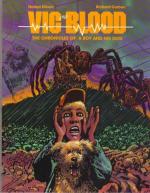|
This section contains 1,610 words (approx. 5 pages at 400 words per page) |

|
Walker teaches writing and literature courses at the University of Washington. In the following essay, Walker tracks the ways in which Ellison's story suffers from misogynistic and adolescent posturing.
When Marlon Brando, in the 1953 film The Wild One, is asked what he's rebelling against, he answers, "Whaddaya got?" It's an iconic moment in twentieth-century art: a young man casting off societal constraints. In Harlan Ellison's "A Boy and His Dog," Vic adopts this spirit of amorphous protest. He rails against "squares" with "nice whitewashed fences"; he turns manicured poodles into dog chow. What he doesn't do is demonstrate the advantages to be found in the rebellious stance. Vic gains freedom of a sort, but he remains frozen in his own misogynistic and adolescent postures. It's a trade-off with which Ellison appears comfortable.
Ellison's work has long trumpeted the outsider, the dissenter, the man neither caste- nor clock-conscious...
|
This section contains 1,610 words (approx. 5 pages at 400 words per page) |

|




